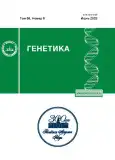Impact of Chromatin 3D-Organization on Promoter–Superenhancer Interactions in Embryonic Stem vs Cancer Cells
- Autores: Eidelman Y.A.1,2, Andreev S.G.1,2
-
Afiliações:
- Emanuel Institute of Biochemical Physics, Russian Academy of Sciences
- National Research Nuclear University “MEPHI”
- Edição: Volume 59, Nº 6 (2023)
- Páginas: 676-686
- Seção: МАТЕМАТИЧЕСКИЕ МОДЕЛИ И МЕТОДЫ
- URL: https://bakhtiniada.ru/0016-6758/article/view/134608
- DOI: https://doi.org/10.31857/S0016675823060036
- EDN: https://elibrary.ru/SRUZYX
- ID: 134608
Citar
Texto integral
Resumo
The interaction of enhancers and superenhancers (SE) with promoters is functionally significant for the regulation of gene expression. Pattern of these interactions plays a key role in various processes, such as differentiation, malignant transformation, etc. In order to quantify the relationship between 3D chromatin organization and promoter–SE contacts, a computational analysis of chromatin conformations near the murine Nanog pluripotency gene was performed for normal embryonic stem (mESC) and lymphoma (CH12LX) cells. Using biophysical modeling approach, the following parameters of the promoter–SE interactions were identified: the distribution of distances between the Nanog promoter and the SEs, the frequency of contacts with one and several SEs simultaneously. In normal mESC expressing Nanog, the frequency of contacts of promoters with SEs is higher than in cancer cells, and complex contacts with two or more SEs are more frequent. The modelling reveals a small subpopulation of cancer cells, where the promoter contacts simultaneously three SEs. The predicted subpopulation of cancer cells with multiple promoter–SE contacts may be predisposed to increased stemness and hypothetically be considered as a reservoir for generation of cancer stem cells.
Palavras-chave
Sobre autores
Yu. Eidelman
Emanuel Institute of Biochemical Physics, Russian Academy of Sciences; National Research Nuclear University “MEPHI”
Autor responsável pela correspondência
Email: eidel@mail.ru
Russia, 119334, Moscow; Russia, 115409, Moscow
S. Andreev
Emanuel Institute of Biochemical Physics, Russian Academy of Sciences; National Research Nuclear University “MEPHI”
Autor responsável pela correspondência
Email: andreev_sg@mail.ru
Russia, 119334, Moscow; Russia, 115409, Moscow
Bibliografia
- Hnisz D., Abraham B.J., Lee T.I. et al. Super-enhancers in the control of cell identity and disease // Cell. 2013. V. 155. № 4. P. 934–947. https://doi.org/10.1016/j.cell.2013.09.053
- Dekker J., Rippe K., Dekker M., Kleckner N. Capturing chromosome conformation // Science. 2002. V. 295. № 5558. P. 1306–1311.https://doi.org/10.1126/science.1067799
- Lieberman-Aiden E., van Berkum N.L., Williams L. et al. Comprehensive mapping of long-range interactions reveals folding principles of the human genome // Science. 2009. V. 326. № 5950. P. 289–293. https://doi.org/10.1126/science.1181369
- Zhang B., Wolynes P.G. Topology, structures, and energy landscapes of human chromosomes // Proc. Natl Acad. Sci. USA. 2015. V. 112. № 19. P. 6062–6067. https://doi.org/10.1073/pnas.1506257112
- Eidelman Y., Salnikov I., Slanina S., Andreev S. Chromosome folding promotes intrachromosomal aberrations under radiation- and nuclease-induced DNA breakage // Int. J. Mol. Sci. 2021. V. 22. № 22. P. 12186. https://doi.org/10.3390/ijms222212186
- Beagrie R.A., Scialdone A., Schueler M. et al. Complex multi-enhancer contacts captured by genome architecture mapping // Nature. 2017. V. 543. № 7646. P. 519–524. https://doi.org/10.1038/nature21411
- Giorgetti L., Galupa R., Nora E.P. et al. Predictive polymer modeling reveals coupled fluctuations in chromosome conformation and transcription // Cell. 2014. V. 157. № 4. P. 950–963. https://doi.org/10.1016/j.cell.2014.03.025
- Annunziatella C., Chiariello A.M., Bianco S., Nicodemi M. Polymer models of the hierarchical folding of the Hox-B chromosomal locus // Phys. Rev. E. 2016. V. 94. № 4-1. P. 042402. https://doi.org/10.1103/PhysRevE.94.042402
- The ENCODE Project Consortium. An integrated encyclopedia of DNA elements in the human genome // Nature. 2012. V. 489. № 7414. P. 57–74. https://doi.org/10.1038/nature11247
- Anders S., Pyl P.T., Huber W. HTSeq – a Python framework to work with high-throughput sequencing data // Bioinformatics. 2015. V. 31. № 2. P. 166–169. https://doi.org/10.1093/bioinformatics/btu638
- Dixon J.R., Selvaraj S., Yue F. et al. Topological domains in mammalian genomes identified by analysis of chromatin interactions // Nature. 2012. V. 485. № 7398. P. 376–380. https://doi.org/10.1038/nature11082
- Rao S.S.P., Huntley M.H., Durand N.C. et al. A 3D map of the human genome at kilobase resolution reveals principles of chromatin looping // Cell. 2014. V. 159. № 7. P. 1665–1680. https://doi.org/10.1016/j.cell.2014.11.021
- Novo C.L., Javierre B.-M., Cairns J. et al. Long-range enhancer interactions are prevalent in mouse embryonic stem cells and are reorganized upon pluripotent state transition // Cell Rep. 2018. V. 22. № 10. P. 2615–2627. https://doi.org/10.1016/j.celrep.2018.02.040
- Whyte W.A., Orlando D.A., Hnisz D. et al. Master transcription factors and mediator establish super-enhancers at key cell identity genes // Cell. 2013. V. 153. № 2. P. 307–319. https://doi.org/10.1016/j.cell.2013.03.035
- Ron G., Globerson Y., Moran D., Kaplan T. Promoter-enhancer interactions identified from Hi-C data using probabilistic models and hierarchical topological domains // Nat. Commun. 2017. V. 8. № 1. P. 2237. https://doi.org/10.1038/s41467-017-02386-3
- Liu L., Kim M.H., Hyeon C. Heterogeneous loop model to infer 3D chromosome structures from Hi-C // Biophys. J. 2019. V. 117. № 3. P. 613–625. https://doi.org/10.1016/j.bpj.2019.06.032
- Wang M.-L., Chiou S.-H., Wu C.-W. Targeting cancer stem cells: emerging role of Nanog transcription factor // Onco. Targets Ther. 2013. V. 6. P. 1207–1220. https://doi.org/10.2147/OTT.S38114
- Schoenfelder S., Fraser P. Long-range enhancer-promoter contacts in gene expression control // Nat. Rev. Genet. 2019. V. 20. № 8. P. 437–455. https://doi.org/10.1038/s41576-019-0128-0
- Finn E.H., Mistely T. Molecular basis and biological function of variability in spatial genome organization // Science. 2019. V. 365. № 6457. P. eaaw9498. https://doi.org/10.1126/science.aaw9498
- Sood V., Misteli T. The stochastic nature of genome organization and function // Curr. Opin. Genet. Dev. 2022. V. 72. P. 45–52. https://doi.org/10.1016/j.gde.2021.10.004
Arquivos suplementares













